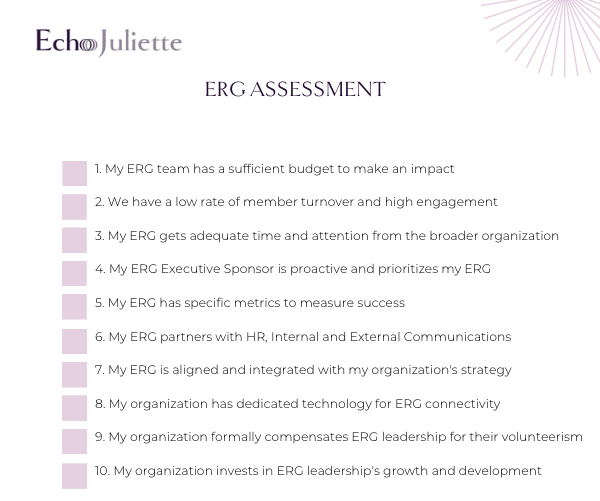In the last two weeks I have been thinking about networking groups and what makes them effective.
I joined my first Employee Resource Group (ERG) on September 14, 2001. I was the most senior woman in the Office of the CEO and the Global Head of Diversity called me to ask for my support convincing our company not to cancel our 2,000 attendee women’s conference scheduled for a month’s time. Given the events of 9/11 canceling was perfectly justifiable, but she felt women wanted it, even needed it.
Long story short, even though I hadn’t met her before and wasn’t involved in the conference or the women’s network I went all-in and made it happen (note: it wasn’t easy!)


After that I joined the steering committee for the next year’s conference and then the leadership team of the women’s network.
It connected me to other women who shared my experiences and challenges. We were supportive of each other and put together events that provided inspiration and encouragement, but we weren’t measurably impacting women’s careers.
It wasn’t until we created an initiative that selected 19 senior women leaders who had the potential to make it all the way to the top of the organization that we started seeing an impact.
We created a directory with these women so that leaders across the globe would know who they were. Our CEO got the idea to invite them to the Senior Management Conference which had only had 7 women in attendance, out of 250, the year prior.
Those 19 women then started formally mentoring the next level of women. Providing them with career guidance and directly advocating for their promotions. For the first time in my career I felt a strength in numbers effect from being a part of a women’s network in a male-dominated industry.
Two years after joining the program (I was one of the original 19) my business was moved from department to another and the second day after meeting me our new boss offered me a promotion and an international move. He told me he had been looking for someone externally for over a year.
After we were working together for some time I asked him, “I was here the whole time, did you even bother to look in the senior women’s directory?” Neither he nor HR had.
I had that role for 3 years until I was promoted again. When it came time to replace myself I asked the recruiter to show us external candidates – he only brought me men. I also introduced my boss to an internal woman I knew through the network. He chose the woman.
During my 15 years in the women’s network I would say that it helped my career 5% and helped me personally 95%. Part of this was because there weren’t any women more senior than me and the men weren’t integrated into the network in a way that benefitted women. Two keys to having a network that benefits women’s careers.
Now I am part of several other networks. Namely, Chief, which is a global network of C-Suite and Board Level women and The Upside, which is a curated members group for B2B consultants and advisors. Both of those networks have their own % Career / % Personal benefits and are transparent about what they offer to benefit each.
I am also in two smaller 100% Personal groups, one working on racism and one on mindset and spiritual growth because those personal development topics are challenging and require both close knit support and healthy conflict.
We all know that time is valuable and limited, so the more intentional we are about how we spend our time, the more fulfilling our lives will be. I leave you with these two questions to ponder:
– What groups and networks have you incorporated into your career and life?
– Are you clear on the impact objective of those groups?
The critical success factor for any network or group is that the objectives are transparent so that members can be as aligned as possible. If the members are expecting a group to be something it is not, then everybody loses.
From the Executive Maven Toolkit
Since we are talking about networks and employee groups I have pulled our ERG Assessment out of our library to share with you.
I will caveat this by saying that just because something is on the list doesn’t mean it is right for you. We should learn from what others have done but make sure that we are designing systems that best support our unique organizations and employees.
I work with a lot of ERGs and they all have different objectives and constructs, the key to success is to be intentional.


From Elizabeth on LinkedIn
My most popular post in the last two weeks was about my new LinkedIn Top Voices Badge.


I am always humbled (if not a bit embarrassed) when the post of the issue is related to me and not to you, but it says a lot about you – always showing up to support me!
However, I think this post is actually about you as well.
It is no secret that my superpower is developing High Performance Teams. Many of you have been on those teams, others of you have hired me to facilitate your strategy off-sites, and some of you have asked me to partner with your leadership teams on becoming Five Behaviors® high-performance powerhouses.
You enable me to say I am a High Performance Team expert and I wouldn’t have earned this badge without all of you. Thank you.
Research and Expert Resources
Employee Resource Groups (ERGs) are still being rolled out daily, but did you know they started in the 1970’s?
This report from Boston College shares a comprehensive history and benefits of ERGs.


Note that there are a lot of benefits listed, in my opinion, almost too many. I think that it is more important to have a focused, objective-oriented ERG than it is to have one that tries to do too much. Fortunately research from McKinsey validates my perspective as seen in this chart:


Links and Resources
I am proud to be a Founding Member of Marble Collective, a digital platform that promotes women thought leaders. It is a great place to find speakers, women to follow, topical articles, podcasts, and so much more.
You can check out my profile and relevant links here.



